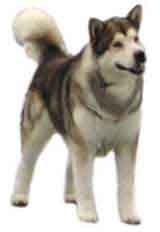Big DogsInformation About The Alaskan Malamute Dog Breed |
|
|
History and origin : The Alaskan Malamute is named after a native tribe called the "Mahlemuts." He is closely related to other Spitz-types such as the Samoyed and has been used as a sled dog. Bred for strength, endurance, and independence, he has the ability to tolerate extremely low temperatures. Today Malamutes are used in sled-pulling competitions, some being able to pull a sled weighing close to a ton. Description : The Alaskan Malamute stands 23 to 26 inches at the shoulder and usually weighs 75 to 125 pounds, while some are even larger. He is thick-boned and has a large, muscular body. The weather-resistant coat is thick, heavy, and of medium length. The undercoat is dense and insulative. He sheds abundantly year- round, particularly in early summer. Regular brushing will keep his coat in good condition. The color may be black-and-white with an off-white undercoat, red-and-white, or gray-and-white with an off-white undercoat. About the breed : This is a sociable, affectionate, fast, strong, intelligent, and powerful breed who is always friendly and good-natured but somewhat stubborn. Usually good with children , the Malamute does not make a good watchdog, but he does have a high prey drive and will show aggression toward other dogs. He can be impetuous, dominant, and challenging, and is not the most cooperative breed with regard to obedience training. Early training is important due to the breed's size, level of dominance, and aggression toward animals. The "Come" command is the most difficult to teach a Malamute because of his independent, free-thinking nature, though the females tend to be less dominant and aggressive. A firm, consistent training technique must be used with this sometimes resistant breed. He tends to be quite vocal and can be very destructive if not exercised daily. Though he is friendly, keep in mind that this large breed can knock over and hurt a child during play. No roughhousing or chase games should be tolerated. The Malamute loves to dig and will create holes all over your yard. A large kennel with a concrete floor will eliminate this problem. This breed can be left outside during even the coldest winter. Although they are almost always good-natured, there are a few cases of aggression toward people with this breed, particularly from the males. Once this behavior occurs, it is very difficult to modify and usually results in the destruction of the animal. The Malamute lives for only ten to twelve years and can suffer from hip dysplasia, shoulder problems, and bloat. He loves the cold and will suffer in warmer climates. He needs exercise, but should not be run long distances due to his weight and susceptibility to hip and shoulder problems. This breed eats large amounts of food and can develop diarrhea if the diet is changed too rapidly. Altering can lengthen a Malamute's life and help prevent aggression and other behavioral problems. Feeding : Recommended feeding for this breed is 1 ½ - 2 ½ cans (13.3oz) of high-quality meaty product with biscuit added in equal part or 5 cupfuls of a complete, dry dog food. Ideal home : This big, independent breed needs a house with a fenced yard or kennel. He needs a firm, consistent leader who is confident and physically able to deal with a powerful breed. Training should begin early and should include daily socialization, handling, and grooming. Spoiling, cautious, and overbearing persons should avoid this breed, as should the elderly and the disabled.Back to the Big Dog Breed article page
| |
|
Related News About Dogs ' ); // get rid of newsfeed display by carp CarpConf('poweredby',''); CarpCacheShow('http://classifieds.agriscape.com/syndicate/dogs.rss'); ?>
|
|
|
|
|
|
Copyright © 2006-2007 dogguidance.com |


